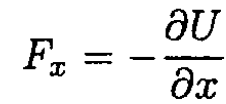


 الفيزياء الكلاسيكية
الفيزياء الكلاسيكية
 الكهربائية والمغناطيسية
الكهربائية والمغناطيسية
 علم البصريات
علم البصريات
 الفيزياء الحديثة
الفيزياء الحديثة
 النظرية النسبية
النظرية النسبية
 الفيزياء النووية
الفيزياء النووية
 فيزياء الحالة الصلبة
فيزياء الحالة الصلبة
 الليزر
الليزر
 علم الفلك
علم الفلك
 المجموعة الشمسية
المجموعة الشمسية
 الطاقة البديلة
الطاقة البديلة
 الفيزياء والعلوم الأخرى
الفيزياء والعلوم الأخرى
 مواضيع عامة في الفيزياء
مواضيع عامة في الفيزياء|
Read More
Date: 29-8-2016
Date: 17-3-2021
Date: 11-8-2016
|
Parallel Plate Capacitor with Solid Dielectric
Two square metal plates of side L are separated by a distance d << L. A dielectric slab of size L × L × d just slides between the plates. It is inserted a distance x (parallel to one side of the squares) and held there (see Figure

Figure 1.1
1.1). The metal plates are then charged to a potential difference V and disconnected from the voltage source.
a) Find the force exerted electrically on the slab. Be careful and explicit about its direction.
b) How does the situation change if the battery is left connected?
SOLUTION
To solve this problem, the capacitance of a parallel plate capacitor must be calculated with and without a dielectric inserted. We then recognize that the two capacitors are in parallel in order to infer the total capacitance, and we then use the expression for the energy contained in the capacitor to determine the force on the dielectric. The potential difference between the plates is given by
 (1)
(1)
where σ is the surface charge density σ = Q/L2. Since Q = CV, we find
 (2)
(2)
a) With a dielectric inserted, the capacitance is modified. E is replaced by D in (1), where D = εE. The potential V is still the integral of –E . dl, so we find that the capacitance is multiplied by ε. In this problem, the dielectric is inserted only a distance x between the plates (see Figure 1.2).

Figure 1.2
As the total capacitance of two capacitors in parallel is simply the sum of the individual capacitances, we find that the new capacitance is
 (3)
(3)
The energy stored in a capacitor is given by
 (4)
(4)
In (a), the battery has been disconnected from the capacitor. As the dielectric moves either into or out of the capacitor, the potential V will change while the charge Q is constant. So we use the first part of (4). The force on the dielectric is found from
 (5)
(5)
From (3) and (4) we have

so
 (6)
(6)
Expressing Fx in terms of a potential difference V

we obtain

Since ε > 1, the dielectric slab will be drawn further between the plates (x will increase).
b) In this case, V is constant, not Q, and we must now take into account the electric potential energy of the battery. For some small change of the system,

Since Q = CV, and the potential is held fixed ∆Q = V ∆C, so

Note the minus sign. If the electric potential energy of the battery had been ignored, the expression would be incorrect. We now wish to find
 (7)
(7)
as obtained in (a). Note that the force goes to zero when ε = 1, as expected.



|
|
|
|
للعاملين في الليل.. حيلة صحية تجنبكم خطر هذا النوع من العمل
|
|
|
|
|
|
|
"ناسا" تحتفي برائد الفضاء السوفياتي يوري غاغارين
|
|
|
|
|
|
|
نحو شراكة وطنية متكاملة.. الأمين العام للعتبة الحسينية يبحث مع وكيل وزارة الخارجية آفاق التعاون المؤسسي
|
|
|